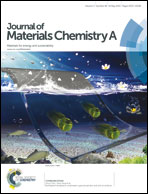Graphitized hierarchical porous carbon nanospheres: simultaneous activation/graphitization and superior supercapacitance performance
Abstract
A novel graphitized porous carbon nanosphere (GPCNS) material obtained by a convenient simultaneous activation and graphitization route, which was realized by heating resorcinol–formaldehyde (RF) resin nanospheres immersed with ZnCl2 and FeCl3 in an inert atmosphere, has been reported. A high graphitization level was achieved through the catalytic graphitization by reduced Fe metal, and the hierarchically micro/mesoporous structure was produced in a controlled fashion by tuning the mass ratio of the activating agent ZnCl2 and a carbon precursor. An optimal sample of GPCNS-2 was prepared with a FeCl3/ZnCl2/RF mass ratio of 0.5 : 2 : 1, exhibiting a highly graphitized framework and uniform spherical morphology with an average diameter of ∼500 nm, as well as well-interconnected micro/mesoporous structure with a large surface area of 1664.8 m2 g−1. Acting as an electrode material for a supercapacitor application in 6 M KOH electrolyte, GPCNS-2 displayed excellent electrochemical performance with a high specific capacitance of 402.5 F g−1 at a current density of 1 A g−1. Moreover, an electrochemical impedance spectroscopy test demonstrated that the low internal electrical resistance of GPCNS-2 contributed a superior rate capability of above 75% retention rate even at 50 A g−1. Furthermore, the GPCNS-2 electrode possessed an outstanding cycling stability, and about 96% of its initial specific capacitance at 5 A g−1 was maintained after 5000 cycles.


 Please wait while we load your content...
Please wait while we load your content...